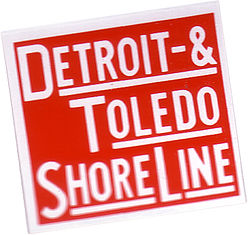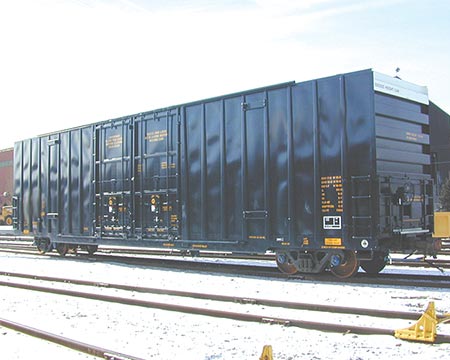Model Information: This body style comes in two different variations: Double Door and Single Door.
Prototype History: In the early 1960s, the auto industry, looking for better and more efficient ways of shipping parts to assembly plants, worked with railroads and car builders to develop specialized freight cars. The primary requirement was the ability to handle a variety of different parts without the use of custom-built interior fixtures and racks. The 60 foot cars were for higher density items such as engines, transmissions and castings. Their big brothers, the 86 footers handled lower-density automotive components such as stamped parts.
Various manufacturers built these cars including ACF, NSC and Pullman. National Steel Car's 103-ton, 60-foot, 9-inch box car is equipped with rub rails and interior lading securement; double 8-foot plug doors that are 12-feet, 9-inches high, have a 16-foot clear opening, 60,000 pound nailable steel floor and 15-inch end of car cushioning. NSC box cars are available with a variety of options and can be tailored to suit specific shipping needs.
Various manufacturers built these cars including ACF, NSC and Pullman. National Steel Car's 103-ton, 60-foot, 9-inch box car is equipped with rub rails and interior lading securement; double 8-foot plug doors that are 12-feet, 9-inches high, have a 16-foot clear opening, 60,000 pound nailable steel floor and 15-inch end of car cushioning. NSC box cars are available with a variety of options and can be tailored to suit specific shipping needs.
Road Name History: The D&TS was built just after the turn of the 20th Century, originally as a fast interurban line connecting Toledo with Detroit. With construction well underway (about 3/4 of the way to Detroit) and some of the trolley wire up, the backers started to run out of money and sold the line to Grand Trunk Western and The Clover Leaf Route, with each getting half. This would give GTW (which blanketed southern Michigan) a friendly connection to the rail hubs at Toledo. The Clover Leaf (officially the Toledo St. Louis & Western) got a friendly connection to Detroit. The trolley wire came down and the track was upgraded to GTW standards. From then on, Detroit & Toledo Shore Line was a multi-track 59 mile speedway for freight. Ironically for a line conceived as an interurban, the D&TS never offered passenger service. Later, they would adopt the motto, “Expressway for Industry.” In 1923, the Nickel Plate Road merged the Clover Leaf and took over their half of the D&TS.
In the steam era, about 30 locomotives were required to run the line. 2-8-2’s and 2-8-0’s handled the road traffic while USRA 0-8-0’s and some smaller switchers worked the yards. The D&TS dieselized in the early 50s with just three EMD models, SW7s and SW9s for switching and GP7s for road service. The 1953 batch of geeps was the last locomotives bought by the railroad! These were delivered in a yellow-over-blue paint scheme. The narrowly focused roster made the shop crews experts at getting the most from the fleet and keeping them running for the next three decades.
The crooked square logo is a nod to Grand Trunk Western while the black and yellow paint scheme adopted around 1959 is a nod to the Nickel Plate. In 1964, the Nickel Plate was merged into Norfolk & Western so they took the 50% stake in the D&TS. The Shore Line kept the Nickel Plate-esque paint scheme until the end however.
D&TS trains routinely ran north past Detroit and into Flint on GTW tracks, while GTW trains ran south all the way to the Toledo Terminal loop. After the 1964 N&W-Nickel Plate-Wabash merger, N&W had a better line west out of Detroit on the former Wabash rather than using the D&TS and the old Clover Leaf (which had been built on the cheap.) From then on, the D&TS became much more important to the GTW than to the N&W. In 1981, N&W finally sold their half to the Grand Trunk Western and the Detroit & Toledo Shore Line was merged into the GTW.
In the steam era, about 30 locomotives were required to run the line. 2-8-2’s and 2-8-0’s handled the road traffic while USRA 0-8-0’s and some smaller switchers worked the yards. The D&TS dieselized in the early 50s with just three EMD models, SW7s and SW9s for switching and GP7s for road service. The 1953 batch of geeps was the last locomotives bought by the railroad! These were delivered in a yellow-over-blue paint scheme. The narrowly focused roster made the shop crews experts at getting the most from the fleet and keeping them running for the next three decades.
The crooked square logo is a nod to Grand Trunk Western while the black and yellow paint scheme adopted around 1959 is a nod to the Nickel Plate. In 1964, the Nickel Plate was merged into Norfolk & Western so they took the 50% stake in the D&TS. The Shore Line kept the Nickel Plate-esque paint scheme until the end however.
D&TS trains routinely ran north past Detroit and into Flint on GTW tracks, while GTW trains ran south all the way to the Toledo Terminal loop. After the 1964 N&W-Nickel Plate-Wabash merger, N&W had a better line west out of Detroit on the former Wabash rather than using the D&TS and the old Clover Leaf (which had been built on the cheap.) From then on, the D&TS became much more important to the GTW than to the N&W. In 1981, N&W finally sold their half to the Grand Trunk Western and the Detroit & Toledo Shore Line was merged into the GTW.
Brand/Importer Information: In 1924 Stephan Schaffan, Sr. founded the Atlas Tool Company in Newark, New Jersey. In 1933 his son, Stephan Schaffan, Jr., came to work for his father at the age of sixteen. Steve Jr. built model airplanes as a hobby and frequented a local hobby shop. Being an enterprising young man, he would often ask the owner if there was anything he could do to earn some extra spending money. Tired of listening to his requests, the hobby-store owner threw some model railroad track parts his way and said, "Here, see if you can improve on this".
In those days, railroad modelers had to assemble and build everything from scratch. Steve Jr. created a "switch kit" which sold so well, that the entire family worked on them in the basement at night, while doing business as usual in the machine shop during the day.
Subsequently, Steve Jr. engineered the stapling of rail to fiber track, along with inventing the first practical rail joiner and pre-assembled turnouts and flexible track. All of these products, and more, helped to popularize model railroading and assisted in the creation of a mass-market hobby. The budding entrepreneur quickly outgrew the limitations of a basement and small garage operation. Realizing they could actually make a living selling track and related products, Steve and his father had the first factory built in Hillside, New Jersey at 413 Florence Avenue in 1947. On September 30, 1949, the Atlas Tool Company was officially incorporated as a New Jersey company.
In 1985, Steve was honored posthumously for his inventions by the Model Railroad Industry Association and was inducted into the Model Railroad Industry Hall of Fame in Baltimore, Maryland. In addition, Steve was nominated and entered into the National Model Railroad Association Pioneers of Model Railroading in 1995.
In the early 1990s, the Atlas Tool Company changed its name to Atlas Model Railroad Company, Inc.
In those days, railroad modelers had to assemble and build everything from scratch. Steve Jr. created a "switch kit" which sold so well, that the entire family worked on them in the basement at night, while doing business as usual in the machine shop during the day.
Subsequently, Steve Jr. engineered the stapling of rail to fiber track, along with inventing the first practical rail joiner and pre-assembled turnouts and flexible track. All of these products, and more, helped to popularize model railroading and assisted in the creation of a mass-market hobby. The budding entrepreneur quickly outgrew the limitations of a basement and small garage operation. Realizing they could actually make a living selling track and related products, Steve and his father had the first factory built in Hillside, New Jersey at 413 Florence Avenue in 1947. On September 30, 1949, the Atlas Tool Company was officially incorporated as a New Jersey company.
In 1985, Steve was honored posthumously for his inventions by the Model Railroad Industry Association and was inducted into the Model Railroad Industry Hall of Fame in Baltimore, Maryland. In addition, Steve was nominated and entered into the National Model Railroad Association Pioneers of Model Railroading in 1995.
In the early 1990s, the Atlas Tool Company changed its name to Atlas Model Railroad Company, Inc.
Item created by: CNW400 on 2019-03-18 10:39:16. Last edited by lafitte23 on 2021-11-12 19:22:27
If you see errors or missing data in this entry, please feel free to log in and edit it. Anyone with a Gmail account can log in instantly.
If you see errors or missing data in this entry, please feel free to log in and edit it. Anyone with a Gmail account can log in instantly.











